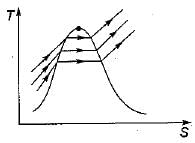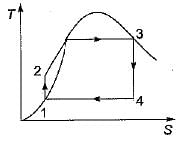Test: Analysis of Steam Cycles - 3 - Mechanical Engineering MCQ
30 Questions MCQ Test - Test: Analysis of Steam Cycles - 3
For a mercury-steam-sulphur dioxide cycle, the heat rejected in the mercury cycle is given to the steam cycle and the heat rejected in the steam cycle is utilized in the SO2 cycle. If the efficiencies of the mercury, steam and SO2 cycles are 0.52,0.41 and 0.25 respectively, what is the overall efficiency of the composite cycle?
Consider the following advantages of combined gas-steam cycles:
1. High overall plant efficiency
2. Low investment cost
3. Small amount of water required
4. Quick start-up but slow shut-down
Q. Which of the above statements are correct?
1. High overall plant efficiency
2. Low investment cost
3. Small amount of water required
4. Quick start-up but slow shut-down
Q. Which of the above statements are correct?
Heating of dry steam above saturation temperature is known as
At critical point the enthalpy of vaporization is
When saturation pressure of water vapour increases
The correct representation of a simple Rankine cycle on a T-S diagram is
In the Rankine cycle, the heat rejection process takes place at constant
A superheat Rankine Cycle is shown in the given T - S diagram. Starting from the feed pump, the fluid flow upto the boiler exit is represented by straight-line.

In the Rankine cycle the lower limit on the condenser pressure is due to the
Reheating of steam under ideal condition takes place at constant
Employing superheated steam in turbine leads to
The reheat cycle in steam power plant is mainly adopted to
The curve labelled 1 - 2 in the given figure refers to the expansion process of a

What is the difference between the temperature of feed water outlet and saturation temperature of steam entering the heater called?
Consider an actual regenerative Rankine cycle with one open feed water heater. For each kg steam entering the turbine, if m kg steam with a specific enthalpy of h1 is bleed from the turbine, and the specific enthalpy of liquid water entering the heater is h2, then h3 specific enthalpy of saturated liquid leaving the heater is equal to
For a given sot of operating pressure limits of a Rankine cycle, the highest efficiency occurs for
A steam plant has the boiler efficiency of 92%, turbine efficiency (mechanical) of 94%, generator efficiency of 95% and cycle efficiency of 44%. If 6% of the generated power is used to run the auxiliaries the overall plant efficiency is
Stirling cycle and a Carnot cycle operate between 50° and 350°C. Their efficiencies are ηs and ηc respectively. In this case, which of the following statements is true?
The efficiency of superheat Rankine cycle is higher than that of simple Rankine cycle because
Which one of the following cycles working within the same temperature limits has the highest work ratio?
When two binary vapour cycles (with topping cycle and bottoming cycle) are coupled in series, what is the overall efficiency?
For a mercury-steam sulphur-dioxide cycle, the heat rejected in the mercury cycle is given to the steam cycle and the heat rejected in the steam cycle is utilized in SO2 cycle. If the efficiencies of the mercury, steam and SO2 cycle 0.5, 0.4 and 0.25 respectively, then overall efficiency of the composite cycle is
The efficiency of Carnot cycle may be equal to any one of the following cycles running between same two temperature limits. Which one is it?
In a simple Rankine cycle, steam enters the condenser at saturated vapour and leaves as saturated liquid. The condenser the boiler pressures are maintained at ρ1 and ρ2, respectively. If vf and vg are the specific volumes of saturated liquid and saturated vapour at condenser pressure, then pump work can be approximated as
The ideal cycle for a steam power plant is the Rankine cycle instead of the Carnot cycle because
The adiabatic enthalpy drop across the prime mover of the Rankine cycle is 840 kJ/kg. The enthalpy of steam supplied is 294 kJ/kg. If the back pressure is 0.1 bar the specific steam consumption is lf hf at 0.1 bar = 191.8 kJ/kg.
Group-I shows different heat addition processes in power cycle. Like wise Group-II shows different heat removal processes. Group-Ill lists Power cycles.
Match item from Group I, II and III
Group-I
P-Pressure const.
Q-Volume const.
R-Temp Const.
Group-II
S-Pressure Const.
T-Volume const.
U-Temp const.
Group-Ill
1. Rankine cycle
2. Otto cycle
3. Carnot cycle
4. Diesel cycle
5. Brayton cycle
Consider the following statements:
The efficiency of the vapour power Rankine cycle can increased by
1. Increasing the temperature of the working fluid at which heat is added
2. Increasing the pressure of the working fluid at which heat is added
3. Decreasing the temperature of the working fluid at which heat is reject
Q. Which of these statements is/are correct?
The enthalpy of steam entering a turbine is a rankine cycle is 3200 KJ/Kg. The enthalpy after isentropic expansion is 2400 KJ/Kg and enthalpy at the end of actual expansion is 2560 KJ/Kg. What is the turbine efficiency?
Consider the following statements regarding superheating in Rankine Cycles:
1. it reduces the specific steam consumption.
2. it increase the dryness fraction of steam at the exhaust for the same value of condenser pressure.
3. It reduces the cycle efficiency
Of these statements:

























